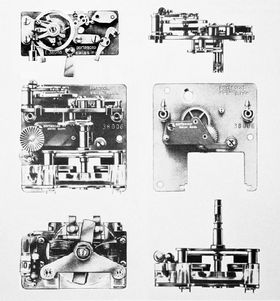Portescap Transistoruhrwerk: Unterschied zwischen den Versionen
Keine Bearbeitungszusammenfassung |
Keine Bearbeitungszusammenfassung |
||
| (8 dazwischenliegende Versionen von 2 Benutzern werden nicht angezeigt) | |||
| Zeile 1: | Zeile 1: | ||
[[Datei:Portescap Transistoruhrwerk.jpg|thumb|280px|'''Portescap Transistoruhrwerk'''<br>''Oben'', Echappement<br>''Mitte Links'', Komplettes Werk<br>''Mitte Rechts'', Platine mit Zeigerwerk<br>''Unten'', Motorantrieb]] | |||
[[Datei:Portescap Transistoruhrwerk.jpg|thumb|'''Portescap Transistoruhrwerk'''<br>''Oben'', Echappement<br>''Mitte Links'', Komplettes Werk<br>''Mitte Rechts'', Platine mit Zeigerwerk<br>''Unten'', Motorantrieb]] | |||
'''Portescap Transistoruhrwerk''' | '''Portescap Transistoruhrwerk''' | ||
Die Firma [[Portescap]], Le Porte Echappement Universal La Chaux De Fonds S. A, produzierte neben die bekannte [[Incabloc]] [[Stoßsicherung]]en auch ein Transistoruhrwerk. Dieses werk benötigt ein Batterie, welche durch die transitorisierte Elektronik ein standig rundlaufende Motor antreibt und dadurch das Räderwerk antreibt. Die zeitmessung folgt über ein Echappement (Hemmung) mit spezielle | Die Firma [[Portescap]], Le Porte Echappement Universal La Chaux De Fonds S. A, produzierte neben die bekannte [[Incabloc]] [[Stoßsicherung]]en auch ein Transistoruhrwerk. Dieses werk benötigt ein [[Batterie]], welche durch die transitorisierte Elektronik ein standig rundlaufende Motor antreibt und dadurch das Räderwerk antreibt. Die zeitmessung folgt über ein Echappement (Hemmung) mit spezielle konstanter Kraft antrieb. | ||
"The Secticon clock constant-force escapement was introduced in the 1960s. The driving motor roller winds the remontoire spring via the intermediate roller and the impulse arm, which is latched by the permanent magnet. On the anticlockwise vibration of balance, the impulse pin enters the fork of the impulse arm, which unlatches from the permanent magnet and gives impulse to the balance. At the end of the impulse arm's travel, the roller locking nib is advanced by pallet, enabling the action to continue. Constant-force escapements can give the highest performance, but cost of manufacture and difficulty in adjustment make this complicated escapement rather rare". | |||
| Zeile 13: | Zeile 14: | ||
Datei:Zeichnung Portescap, Echappement für Transistoruhrwerk.jpg|Zeichnung Echappement beim Patent. | Datei:Zeichnung Portescap, Echappement für Transistoruhrwerk.jpg|Zeichnung Echappement beim Patent. | ||
Datei:Portescap Echappement für Transistoruhrwerk.jpg|Echappement detail. | Datei:Portescap Echappement für Transistoruhrwerk.jpg|Echappement detail. | ||
Datei:Portescap Motorantrieb für Transistoruhrwerk.jpg|Motorantrieb detail. | |||
Datei:Portescap Transistorwerk-Echappement, Teile.jpg|Portescap Transistorwerk-Echappement, Teile mit Nummerverzeichnis. | Datei:Portescap Transistorwerk-Echappement, Teile.jpg|Portescap Transistorwerk-Echappement, Teile mit Nummerverzeichnis. | ||
Datei:Portescap Motor für Transistorwerk.jpg|Portescap Transistorwerk-Motorantrieb, Teile mit Nummerverzeichnis. | |||
</gallery> | </gallery> | ||
[[Kategorie:Archiv Portescap]] | |||
[[Kategorie:Portescap | |||
Aktuelle Version vom 23. Oktober 2012, 23:07 Uhr

Oben, Echappement
Mitte Links, Komplettes Werk
Mitte Rechts, Platine mit Zeigerwerk
Unten, Motorantrieb
Portescap Transistoruhrwerk
Die Firma Portescap, Le Porte Echappement Universal La Chaux De Fonds S. A, produzierte neben die bekannte Incabloc Stoßsicherungen auch ein Transistoruhrwerk. Dieses werk benötigt ein Batterie, welche durch die transitorisierte Elektronik ein standig rundlaufende Motor antreibt und dadurch das Räderwerk antreibt. Die zeitmessung folgt über ein Echappement (Hemmung) mit spezielle konstanter Kraft antrieb.
"The Secticon clock constant-force escapement was introduced in the 1960s. The driving motor roller winds the remontoire spring via the intermediate roller and the impulse arm, which is latched by the permanent magnet. On the anticlockwise vibration of balance, the impulse pin enters the fork of the impulse arm, which unlatches from the permanent magnet and gives impulse to the balance. At the end of the impulse arm's travel, the roller locking nib is advanced by pallet, enabling the action to continue. Constant-force escapements can give the highest performance, but cost of manufacture and difficulty in adjustment make this complicated escapement rather rare".
Weitere Bilder Portescap Transistoruhrwerk
-
Zeichnung Echappement beim Patent.
-
Echappement detail.
-
Motorantrieb detail.
-
Portescap Transistorwerk-Echappement, Teile mit Nummerverzeichnis.
-
Portescap Transistorwerk-Motorantrieb, Teile mit Nummerverzeichnis.




